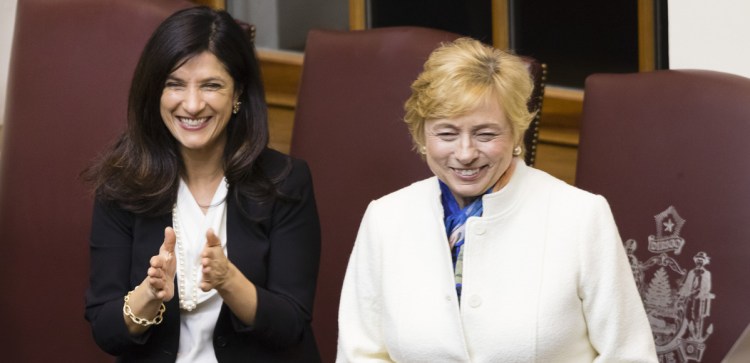As a candidate, Janet Mills laid out her vision for Maine. With her first budget proposal as governor, she put it in writing – and set the terms of debate for the legislative session.
In her budget address Monday night, Mills described Maine as a state that had a lot to be proud of, but which has been held back by a failure to invest in the health and education of its residents.
The new governor said correctly that Maine has not capitalized on the country’s long-term economic boom, and is faced with workforce shortages and projections of virtually zero job growth. We have challenges, too, she said, with child poverty, unaffordable and/or unavailable senior housing, lagging educational attainment and poor health.
In addressing those challenges, Mills is prioritizing health care, a central part of her campaign, and an issue that took up about half of her 30-minute budget address.
Mills’ budget pays to expand Medicaid, using $147 million in state funds to leverage about $1 billion in federal spending over the two-year budget, supporting jobs and hospitals throughout the state. Expansion will help up to 70,000 low-income Mainers who need insurance, and it will reduce the cost of health care and insurance by cutting down on charity care, the governor said as she made the case that a healthier state will benefit everyone.
The budget also addresses the opioid crisis and public health, adding money for treatment and recovery – in addition to other moves outside the budget – while restoring the public health infrastructure dismantled during the previous administration.
There is also an additional $126 million for schools as well as a slight uptick in municipal revenue sharing in the budget, both aimed at reducing property taxes.
Mills’ budget recognizes some of the statutory funding requirements that Paul LePage all but ignored as governor, and makes long-overdue new investments in health and education. As the governor said Monday, Maine “cannot afford to stand still.”
That may not be enough for some Democrats, as neither school funding nor revenue sharing meet their statutory targets.
Meeting those goals on top of the others would have required raising taxes, something Mills has promised not to do. For progressives who want to repeal LePage’s tax cuts – most of which benefited the wealthy – and use that money to fund further Democratic priorities, that’s a point of friction, though how much of one is unclear.
Republicans, mostly quiet on the lack of a tax increase, have instead attacked the sheer size of the budget – $8 billion, or 11 percent higher than the current budget.
After Mills’ speech Monday, Republican legislative leaders said the budget relies on rosy revenue projections and spends “every nickel.” If the economy takes a turn for the worse, they argued, the state would be in trouble.
Republicans ended their rebuttal with a refrain familiar from the last eight years. Lower taxes, Senate Minority Leader Dana Dow said, and prosperity will follow.
That’s where the state budget stands in the early stages, with months likely to go before it is finalized. How will the governor’s revenue and spending figures hold up to scrutiny? How hard will progressive Democrats push Mills? Will Republicans offer any ideas for growth beyond tax cuts and lower spending?
Those questions remain to be answered. But with her first budget, Mills has made a strong case for meeting the challenges facing the state. As she said, Maine cannot stand still – and every budget decision must be made with that in mind.
Send questions/comments to the editors.



Comments are no longer available on this story